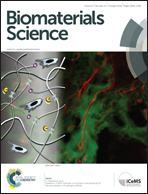Light-reactive dextran gels with immobilized guidance cues for directed neurite growth in 3D models
Abstract
We present here a novel light-reactive dextran gel for immobilizing guidance cues in neural growth models. The dextran gel is functionalized with glycidyl methacrylate to afford crosslinking abilities, and is combined with polyethylene glycol (PEG) acrylate grafted with thiol groups caged by a UV-light sensitive moiety. The gel is chemically crosslinked within a cell-restrictive PEG micromold with two channels, and then irradiated with UV light to liberate the thiol groups in a spatially defined manner. Maleimide-conjugated NeutrAvidin (NA), neurotrophin-3 (NT-3) and semaphorin 3A (Sema3A) are then bound to the free thiols, resulting in regions of immobilized guidance cues. Dorsal root ganglia explants were cultured in these dual hydrogel constructs, and the neurite response was quantified by comparing the neurite growth in the channel with the immobilized cue to the channel without any protein. We found that immobilized NT-3 elicited a moderate attractive response, while bound Sema3A elicited a strong repulsive response from neurites. This work establishes a model for investigating growth cone responses to immobilized cues in three dimensions.


 Please wait while we load your content...
Please wait while we load your content...